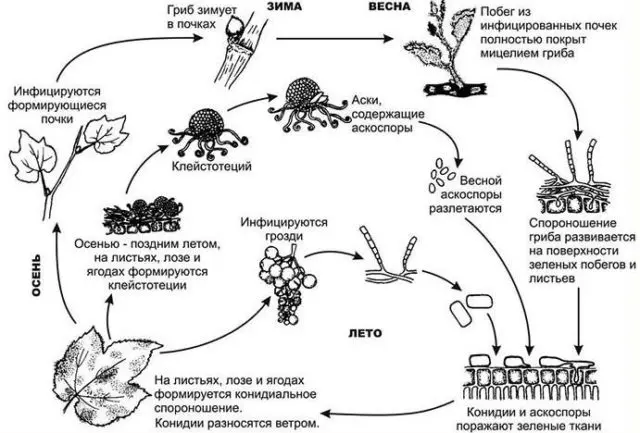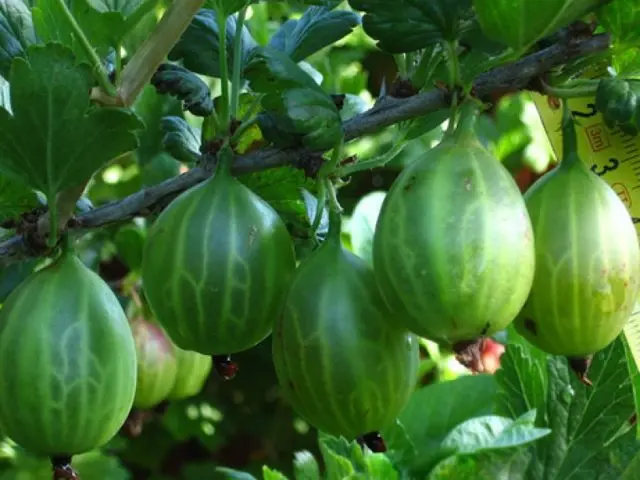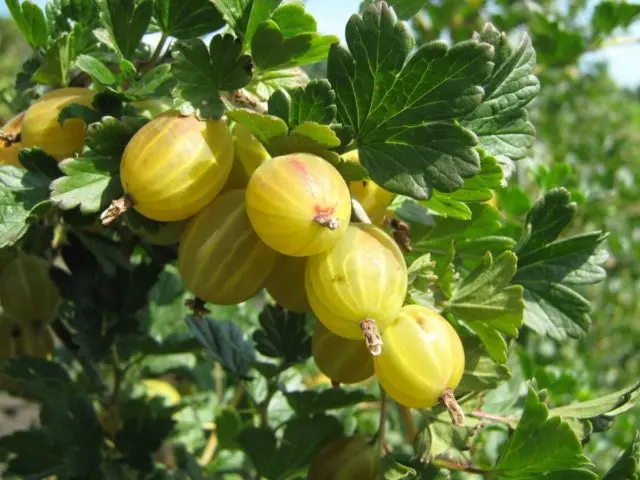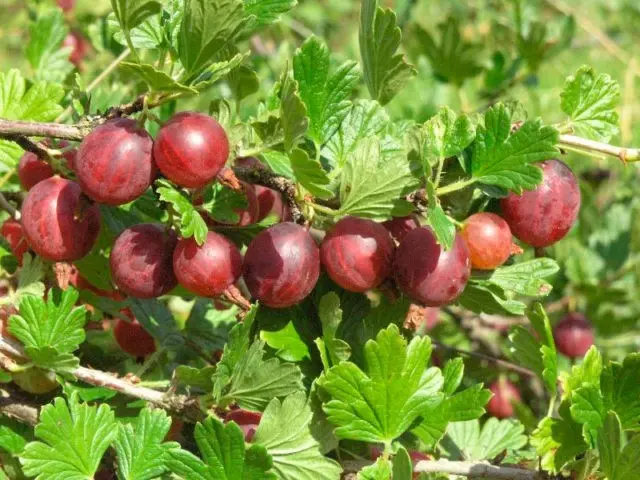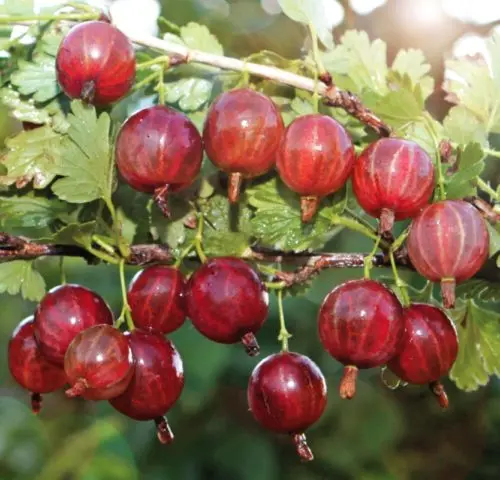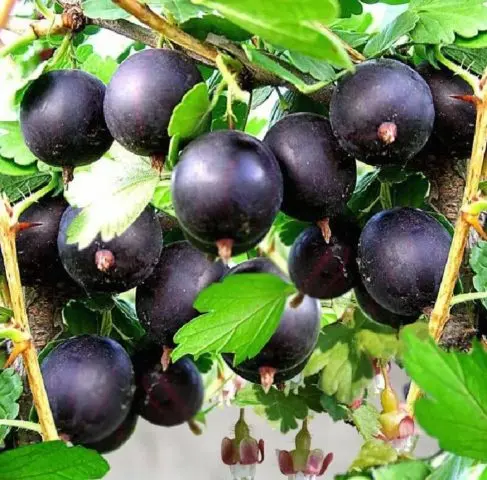Contents
Powdery mildew is a very common disease affecting many horticultural crops. These include berry bushes, which include gooseberries. Next, it will be told when it is better to treat gooseberries from powdery mildew in the spring, what preparations are best used for this and what results this can bring.
Signs of powdery mildew on gooseberries
The causative agent of powdery mildew is a fungus that affects all above-ground parts of the plant: shoots, berries, leaves. It usually appears at the beginning of summer, the gooseberry is covered with a white coating, the affected areas look as if they were sprinkled with flour or light ash. Because of this, the disease is often called linen or ashtray. Over time, the plaque darkens, turns brown and acquires a dense structure. Affected shoots stop growing, deform and dry out, the leaves turn brown, curl and completely dry out, gooseberry berries crumble before they ripen, crack or become covered with a white coating, and then with a dense brown crust.
In the photo below – a white coating of powdery mildew on gooseberry leaves and affected berries.
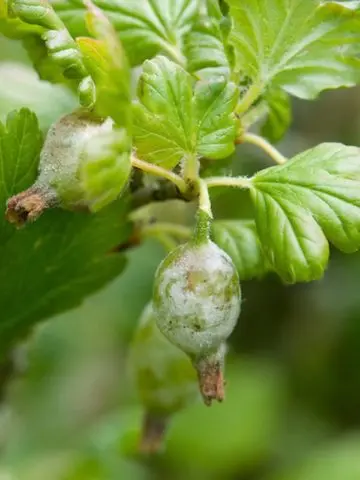
Over time, the disease progresses, the spores of the fungus are carried by wind and water to other parts of the bushes and neighboring plantings. If you do not take measures for treatment, the bush will completely die within 2-3 years.
There are 2 types of powdery mildew:
- American (sforoteka). It forms a powdery coating on young leaves and shoots, which eventually acquires a felt structure and brown color.

- European. It manifests itself in the form of a cobweb-like thin plaque on the leaves. The fruit bodies of the fungus are small, black. It is now very rare, since at the beginning of the last century it was almost universally replaced by American gooseberry powdery mildew.

Signs of gooseberry damage by this fungal disease can be seen by the characteristic white coating, which is easily erased.
Causes of infection and features of distribution
Most often, the causes of powdery mildew damage are adverse weather conditions, coupled with improper care for shrubs or with a complete lack of it. The development of the disease is facilitated by excessive moisture and thickening of plantings, the presence of fallen leaves and debris in the root zone. In conditions of difficult air exchange, the fungus develops intensively, gradually spreading over all the aerial parts of the plant.
Another factor that increases the risk of gooseberry disease with powdery mildew is an overabundance of nitrogen fertilizers or fresh organics, manure or chicken droppings, which feed berry bushes. The reverse situation is no less dangerous. If the gooseberry bush grows on poor, unfertilized soil, then the risk of fungus increases. Often the disease is the result of improper pruning of the bush. If you do it too much, the gooseberry is very weak and can get sick.
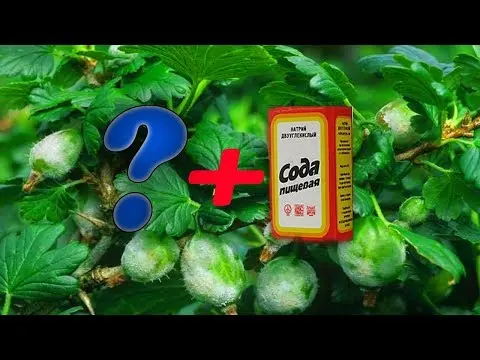
The figure clearly shows 2 stages of development of the fungus: conidial and marsupial. Conidial sporulation, or mycelium, is the same white powdery coating on the shoots and leaves of gooseberries. After infection of the leaves and young shoots, the fungus enters the second phase – the marsupial. Brown plaque on various parts of the plant is nothing more than mycelium with the fruiting bodies of the fungus. In this form, the fungus goes to winter. Bag spores ripen in spring, which open in spring along with the blooming of leaves. Thrown out ascospores infect only young leaves and shoots, ovaries of berries, again forming the same white coating.
How to deal with powdery mildew on gooseberries
Лучший способ борьбы с заболеванием – это профилактика. Если же мучнистая роса на ягодах крыжовника все-таки появилась, то меры нужно принимать незамедлительно.
Agrotechnical measures to combat powdery mildew on gooseberries
Compliance with proper agricultural practices can prevent powdery mildew disease in gooseberries or stop the disease at an early stage. First of all, it concerns the choice of variety at the planting stage. Among the resistant to powdery mildew, the following gooseberry varieties can be distinguished:
- Harlequin.
- Gingerbread Man.
- Finnish.
- Хаутон.
Every spring and autumn, it is necessary to inspect and sanitize the bushes, removing thickened, broken and dry branches, as well as shoots with signs of infection. Fallen leaves in spring and autumn should be completely removed from the root zone and burned or taken out and buried outside the site.
Как спасти крыжовник от мучнистой росы народными средствами
Among the ways to combat this fungal disease, there are many folk, proven by many generations of gardeners. The following formulations can be used for treatment.
- Infusion of wood ash. 1 kg of ash is soaked in 10 liters of heated water, stirred well and allowed to brew for several days. The resulting ash infusion is filtered, and then gooseberry bushes are treated with them three times, on which there is a white coating, making intervals between applications of 2 days.
- Iodine tincture and whey. To prepare the composition for the treatment of gooseberries in 1 liter of serum, add 1-2 drops of a conventional medical solution of iodine.
- Soap solution with soda. For 10 liters of water, 50 g of laundry soap and 2 tbsp. l. baking soda. Before mixing, it is better to grate the soap into shavings on a grater, this will speed up its dissolution.
- Зеленка (спиртовой раствор бриллиантового зеленого). На 10 л воды добавляют 1-2 капли зеленки.
- Aspirin. 2 tablets of acetylsalicylic acid should be diluted in 3 glasses of water.
- Чесночные стрелки. Для приготовления настоя для опрыскивания необходимо залить водой ½ ведра свежих чесночных стрелок. Настоять не менее суток перед применением.
- Mustard. 2 tbsp. l. mustard powder pour a bucket of boiling water. After mixing and cooling, the composition can be used to spray gooseberries.
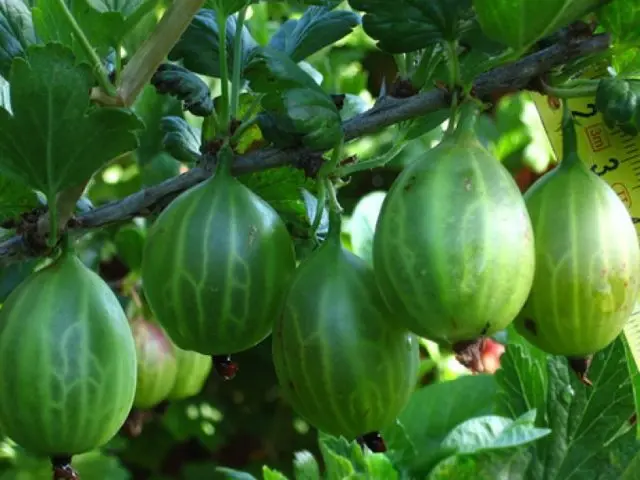
Usually gooseberries are processed in the evening, in dry, cool weather. When spraying, it is very important that the composition also gets on the reverse side of the leaves. It is desirable to process the root zone together with the shrub.
How to deal with white bloom on gooseberries with chemicals
Обработка крыжовника химическими препаратами зачастую оказывается единственным возможным средством спасти кустарник, особенно в запущенных случаях. Традиционно для борьбы с грибковыми заболеваниями садоводы использовали фунгициды – химические соединения, обладающие ярко выраженным противогрибковым действием. К таким веществам относятся, например, соединения меди.
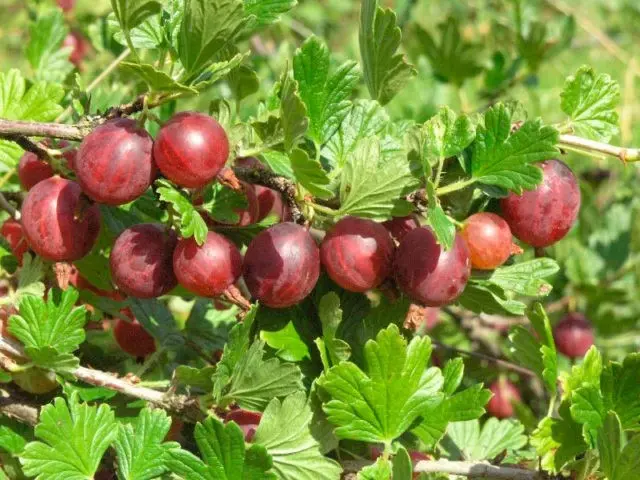
Here are some preparations designed to combat powdery mildew on gooseberries.
- Copper sulfate. A widespread remedy for powdery mildew on gooseberries, which has long been successfully used by many gardeners to combat many fungal diseases. It is a bright blue powder. It dissolves well in water. To prepare a solution for processing gooseberries for 10 liters of water, you need to take 40 g of copper sulfate. To increase the stability of the solution and its wetting ability, 100 g of laundry soap shavings are added to it.
- Topaz. An effective fungicide based on penconazole. The mechanism of action of this drug is to inhibit the spores of the fungus, under the influence of penconazole, they completely stop growing. The drug penetrates perfectly into the tissues of the plant, its effectiveness does not depend on air temperature and humidity.
- Hom. This is nothing more than an abbreviation for the words “copper oxychloride”. An effective fungicide, almost a complete analogue of the famous Bordeaux mixture – a solution of copper sulfate in milk of lime. Sold dry. Before use, the mixture is diluted in water in the desired proportion. It is easily washed off with water, therefore, in cloudy weather, processing is not performed.
- Fundazol. A benomyl-based fungicide that inhibits not only fungi, but also some insect pests, such as spider mites. The drug is non-toxic, well absorbed by all parts of the plant. It can be used for processing gooseberries at various temperatures.
- Vectra. The basis of the drug is a mixture of dichlorophenyl and triazole. Effective against many fungal diseases, stops the growth of pathogens. Non-toxic, does not adversely affect plants and animals. It is quickly absorbed by any tissues and spreads to all parts of the bush
Нередко садоводы применяют против мучнистой росы раствор коллоидной серы. На 10 л воды необходимо 70-80 г серы. Применять раствор для обработки крыжовника необходимо только в свежеприготовленном виде, он не хранится длительное время. А также нельзя использовать его совместно с другими препаратами.
How to cure gooseberries from powdery mildew with biological products
The action of biological products against powdery mildew is based on microorganisms that themselves or in the process of life inhibit pathogenic fungi, inhibit their growth, and prevent reproduction. Unlike chemicals, they are absolutely harmless to plants and animals, they can be used even during the ripening of berries. The disadvantage of biological preparations is a rather short action, after about 2 weeks their activity decreases sharply. Therefore, it is recommended to repeat the treatment monthly. Biologics include:
- Gaupsin.
- Trichodermin.
- Фitosporin.
Rules for the fight against powdery mildew on gooseberries
Before starting the processing of gooseberries, the bushes must be cleaned of diseased and dried shoots, cut off rotten berries, remove fallen leaves, debris and weeds from the root zone. All drugs must be diluted strictly according to the instructions, exactly following the prescribed dosages. With early detection of signs of the disease, it is necessary to use the most gentle, folk methods. After that, it is necessary to evaluate the effectiveness of the use of a particular drug. If the disease continues to progress, it is necessary to move on to more radical methods based on the use of biological products or fungicides.
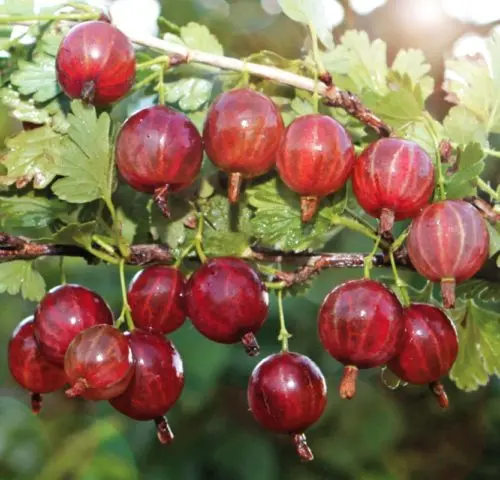
It is better to start processing gooseberries from powdery mildew in early spring. At this stage, until the buds open, it is necessary to spray the bushes with a solution of copper sulfate. It is necessary to process not only the shoots, but also the soil in the root zone. Re-treatment is carried out after flowering. The third time gooseberry bushes are sprayed after harvesting, without waiting for the leaves to fly around. Such treatments are preventive. If spraying is carried out for medicinal purposes, then drugs are used that are most suitable for the degree of damage and the period of vegetative development of the gooseberry.
Informative video on how to treat powdery mildew on gooseberries:
Preventive measures
Preventive measures can significantly reduce the likelihood of powdery mildew on gooseberry bushes. Such measures include the following:
- Prevention of crowded landings. Be sure to observe the intervals between adjacent bushes (at least 1,5 m), the removal of thickening shoots.
- Spring treatment of gooseberries from powdery mildew with boiling water. In early spring, before the start of the growing season, shrubs should be scalded with very hot water, in which a small amount of potassium permanganate or a few tablespoons of soda is diluted. The measure is effective both against pathogens of fungal diseases and against pests whose larvae overwinter in the folds and cracks of the bark.
- Sanitary reading. Annually, in early spring and autumn, it is necessary to remove dry, broken and damaged branches, as well as remove fallen leaves from the root zone.
- Bush fence installation. The bushes should not be allowed to “fall apart” and touch the ground with shoots.
- Spraying It is possible to carry out preventive treatment not only with a solution of copper sulfate. You can use an infusion of mullein, ash or soda ash.
- Refusal to use fresh organic fertilizers. Manure and chicken manure contain a large amount of nitrogen in their composition, which provokes the development of powdery mildew on gooseberries.

The more carefully preventive measures are carried out, the less likely the appearance of powdery mildew on gooseberry bushes. And even if powdery mildew did appear on the gooseberries, it is much easier to cure well-groomed bushes and you don’t have to use serious pesticides for this.
Сорта крыжовника, устойчивые к мучнистой росе
When choosing a gooseberry variety, you should pay attention to varieties that are resistant to powdery mildew. Although there is no complete immunity from this disease, some representatives of these berry bushes are affected by the disease much less frequently. These include the following gooseberry varieties:
- Ural grapes.

- Beryl.

- Firework.

- The Ural Emerald.

- Gingerbread Man.

- Commander

Conclusion
Treating gooseberries from powdery mildew in the spring means securing your future harvest. Even if the appearance of the disease was not registered last season, this procedure should not be neglected. This can significantly reduce the likelihood of the onset of the disease, and if the whole complex of preventive measures is carried out on time, then it can be completely eliminated.










